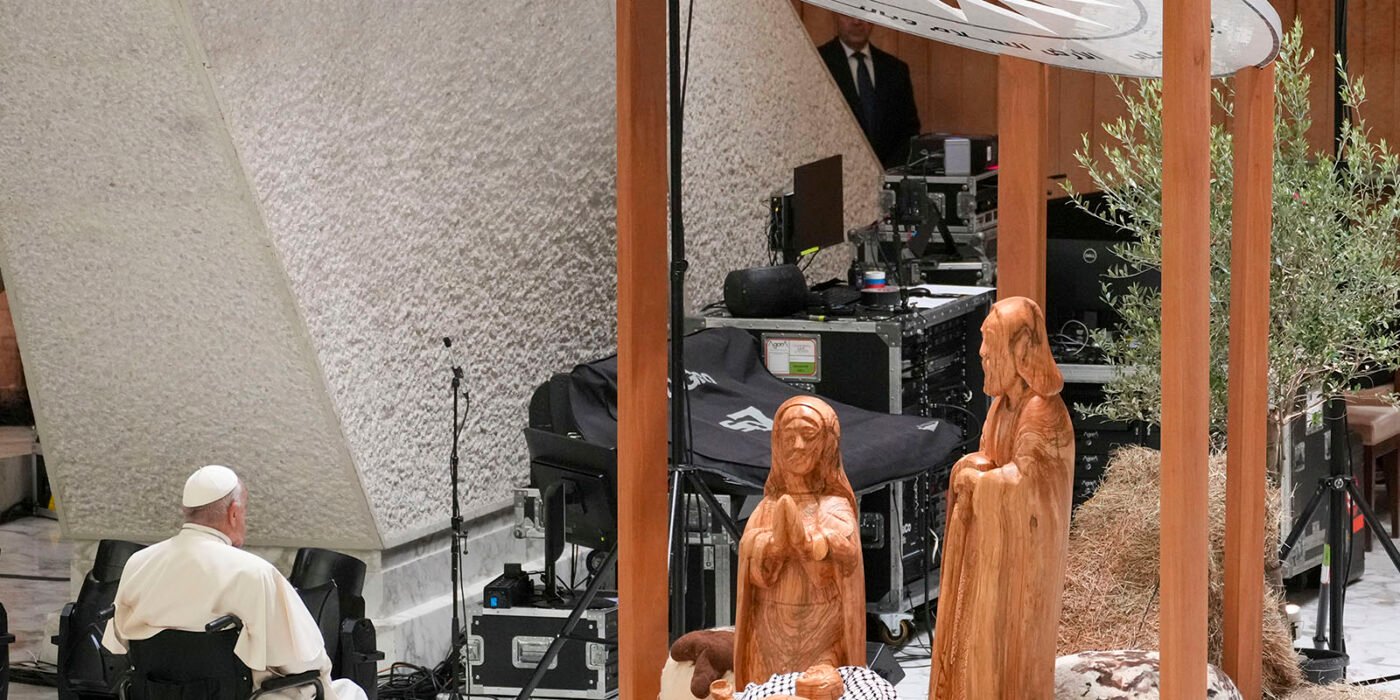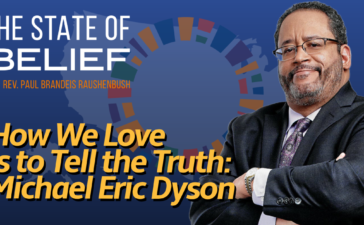VATICAN CITY (RNS) — In the moments before Pope Francis’ arrival at the Paul VI Hall on Saturday (Dec. 7), a final addition was made to a nativity scene gifted by Palestinian artists: A keffiyeh, the black-and-white checkered scarf that has come to represent the Palestinian cause, was placed on the manger beneath the baby Jesus.
Sitting in his wheelchair, Pope Francis was led to the nativity scene where he prayed in silence, before making an impassioned speech for peace in the Middle East. “With tears in our eyes, let us raise our prayer for peace. Brothers and sisters, enough war, enough violence!” the pope said, while looking at the nativity scene.
“The keffiyeh was added at the last minute during the installation phase,” said Faten Nastas Mitwasi, one of the two Palestinian-born artists at Dar al-Kalima University in Bethlehem overseeing the project, alongside Johny Andonia. In an interview with RNS on Thursday (Dec. 12), she said that while it was not their initial intention to turn the nativity into a political statement, they welcomed the final addition of the keffiyeh as a symbol of national identity.
The latest Vatican intrigue revolves around the sudden appearance and even more sudden disappearance of that keffiyeh at the Vatican, but it also highlights the challenges Pope Francis faces as he attempts to navigate a complex geopolitical balance in the Middle East without becoming an instrument of political propaganda.
Nastas Mitwasi started working on the project in March 2023 and said she wanted the work to represent the artistry and heritage of Palestine. The three figures of the baby Jesus with Mary and Joseph were handmade from a single olive tree using typical Palestinian carving techniques. The star hanging above the nativity is shaped from mother of pearl using a style of ornamentation dating back to the 15th century in Bethlehem. The sheep surrounding the scene were made by children of the Ma’n Lilhayt Catholic charity, which offers opportunities for the disabled.
“It’s also the idea that this is a gift from the Palestinian people. So, it’s holding and carrying the Palestinian identity,” she explained.
The Vatican ceremony was a moment of celebration and visibility for Palestinians, most of whom live in Gaza, which has been under siege by Israel for 14 months. Several representatives from the Occupied Palestinian Territories were in attendance, including Ramzi Khouri, who heads the Palestine Liberation Organization; Rev. Mitri Raheb, founder and president of Dar al-Kalima University in Bethlehem; and the Palestinian ambassador to the Holy See, Issa Kassissieh. The ambassador played an important role in bringing the Palestinian nativity to the Vatican, Nastas Mitwasi said.
“It’s displayed at the Vatican so the pope can see it, and the whole world can see it, and celebrate the culture, the beauty of that country,” she added.
The Vatican displayed a nativity scene including Baby Jesus lying on a kaffiyeh.
We are disappointed and troubled that a meaningful religious tradition has been politicized in this way.https://t.co/GJnphmCEjS pic.twitter.com/3KXp6YDh17
— American Jewish Committee (@AJCGlobal) December 9, 2024
The appearance of the keffiyeh on the nativity scene caused quite a stir and was widely reported by major news outlets. Several Jewish organizations expressed concern over its presence at the Vatican.
“We are disappointed and troubled that a meaningful religious tradition has been politicized in this way,” said the American Jewish committee in a post on social media site X. The Jewish Italian media outlet, Maked, expressed “shock and uneasiness” upon seeing the pope before the Palestinian-made nativity.
Several days later on Wednesday, when Pope Francis celebrated his weekly general audience at the Paul VI Hall, the manger — and the keffiyeh — were gone.
The Vatican has stated, in response to broad speculation over the keffiyeh’s disappearance, that it’s tradition for the baby Jesus to be removed from the nativity until the night before Christmas. While true, the explanation doesn’t entirely answer the question of why the manger and the keffiyeh were also removed.
Over 100 nativity scenes are on display beneath the colonnade of Saint Peter’s Square this holiday season, each one holding an infant Jesus in the manger. The large nativity scene in the center of the square, created by the citizens of Grado in northern Italy, also followed the Advent tradition of removing Jesus, and Mary was left holding a lily (the symbol of the Annunciation) until Christmas.
“I don’t know if they will put it back or not,” said Nastas Mitwasi, emphasizing that she hopes the keffiyeh is returned to its place. “We don’t like the idea that they just took parts away,” she added. But the artist also recognizes the Vatican may be under a certain degree of pressure, and the Palestinian-made nativity has already succeeded in putting a spotlight on the war in Gaza — and did so only a few days before Pope Francis was scheduled to meet with Palestinian President Mahmoud Abbas.
A Vatican statement from the meeting on Thursday (Dec. 12) acknowledged the “good bilateral relations” between Palestine and the Holy See. “Reiterating the condemnation of all forms of terrorism, emphasizing the importance of reaching a two-state solution through dialogue and diplomacy, ensuring that Jerusalem, protected by a special status, can be a place of encounter and friendship between the three great monotheistic religions,” the statement read, referring to Islam, Judaism and Christianity, often called the Abrahamic Faiths.
Pope Francis has attempted to toe the line in the Middle Eastern conflict, voicing his closeness to Israel and the hostages who were kidnapped by Hamas on Oct. 7, while condemning the death and suffering of the Palestinian people. As if to maintain that balance, Pope Francis visited Marc Chagall’s masterpiece “The White Crucifixion” at Palazzo Cipolla in Rome on Dec. 9. The 1938 work was made by the Jewish artist in response to Kristallnacht (the night of broken glass), one of the ominous precursors of the Holocaust.
The historically rocky relationship between the Vatican and the Jewish community was somewhat strained in recent months, as Pope Francis strived to take an impartial stand in the Israel-Hamas war. In an interview book with the pope, “El Successor,” Francis called for an investigation into whether Israel’s actions in Gaza constitute genocide, causing outrage among Israel’s advocates and some Jewish faith leaders.
For now, it appears the Vatican has decided to buy time, removing the keffiyeh from the public eye. But the question of how long Pope Francis will be able to continue maintaining an appearance of impartiality — during Christmas and beyond — is a very visible one.






